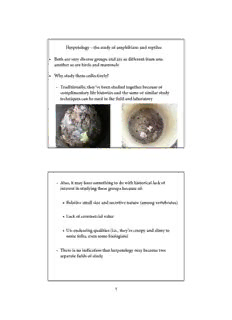
Herpetology – the study of amphibians and reptiles • Both are very diverse groups and are as ... PDF
Preview Herpetology – the study of amphibians and reptiles • Both are very diverse groups and are as ...
Herpetology –the study of amphibians and reptiles • Both are very diverse groups and are as different from one another as are birds and mammals • Why study them collectively? – Traditionally, they’ve been studied together because of complimentary life histories and the same or similar study techniques can be used in the field and laboratory – Also, it may have something to do with historical lack of interest in studying these groups because of: • Relative small size and secretive nature (among vertebrates) • Lack of commercial value • Un-endearing qualities (i.e., they’re creepy and slimy to some folks, even some biologists) – There is no indication that herpetology may become two separate fields of study 1 1 Vertebrate Evolution • Phylum Chordatacharacteristics –may be with organism its entire life or only during a certain developmental stage 1. Dorsal, hollow nerve cord 2. Flexible supportive rod (notochord) running along dorsum just ventral to nerve cord 3. Pharyngeal slits or pouches 4. A tail during some point of development • Phylum Chordatahas 3 subphyla 1. Urochordata–tunicates; adults are sessile marine animals with gill slits • Larvae are free-swimming and possess notochord and nerve cord in muscular tail • Tail is reabsorbed when larvae transforms into an adult 2 2 2. Cephalochordata–lancelets; small marine animals that live in sand in shallow water • Retains gill slits, notochord, and nerve cord thru life 3. Vertebrata –chordates with a “backbone”; persistent notochord, or vertebral column of bone or cartilage • All possess a cranium • All embryos pass thru a stage when pharyngeal pouches are present • Recently, Vertebrata has been changed to Craniatawith 3 superclasses: Myxini(hagfish), Petromyzontida(lampreys) and Gnathastomata(jawed vertebrates) Lamprey ammocoete 3 3 Jawless Fish Lamprey Hagfish Vertebrate Evolution 1. Tunicate larvae 2. Lancelet 3. Larval lamprey (ammocoete) and jawless fishes 4. Jaw development from anterior pharyngeal arches –capture and ingestion of more food sources 5. Paired fin evolution A. Eventually leads to tetrapodlimbs B. Fin spine theory –spiny sharks (acanthodians) had up to 7 pairs of spines along trunk and these may have led to front and rear paired fins 4 4 • Emergence onto land – Extinct lobe-finned fishes called rhipidistiansseem to be the most likely tetrapodancestor • Similar to modern lungfish, had gills and probably lungs to breathe air • Teeth and limb bones closely resemble early amphibian bones 5 5 – Modern “walking” fishinclude walking catfish, mudskippers, and lungfish Lungfish –found in South Mudskipper America, Africa, and Australia Walking catfish –from southeast Asia but now found in Florida – Earliest known amphibians were labyrinthodonts • Had traits of lobe-finned fish and later tetrapods • Most modern salamanders still cannot fully support themselves with their limbs and have unshelled eggs like fish 6 6 • Evolutionary timeline: – Jawless fish –Cambrian Period, 530 MYA – Jawed fish –explosion of fish diversity in Silurian Period(425 MYA) – Terrestrial amphibians –Devonian Period(400 MYA) • Adaptations of some lobe-finned fish that allowed emergence onto land: –Limbs with digits –Lungs –A primitive neck • Fish-like ancestors probably evolved these traits in shallow swamps with stagnant water – Competition and an abundance of unexploited resources may have drove vertebrates onto land – Another theory is that early amphibians lived and fed in water but deposited eggs in moist places on land for better survival of eggs and larvae Coelacanth –modern lobe-finned fish 7 7 • The amniotic egg: reptiles, birds, mammals (amniotes) – Carboniferous Period(320 MYA) – To this day, amphibian eggs are still very similar to those of fish and must be placed in moist areas to develop; no protective shell – Seems to have developed to increase protection of terrestrial eggs from microbes – First, a fibrous shell evolved then, as added protection, a calcerous(calcium) layer was added – All modern-day reptiles deposit calcium crystals in a fibrous matrix 8 8 – Today, most reptile eggs must absorb moisture from the environment to complete development – It is not clear whether extraembyronicmembranes evolved within primitive eggs or female’s oviducts – Earliest amniotes were a group of labyrinthodontscalled anthracosaurs(below) • Amniotes –extraembryonicmembranes – Do not need water to reproduce, no larval stage – Chorion, amnion, and allantoisprovide metabolic support for developing embryo – Yolk sac provides food 9 9 • Adaptive modifications required for terrestrial life: 1. Embryonic development not dependent on standing water 2. Direct development of embryowithout a free-living larval stage 3. Skeletal and muscular supportto withstand increased force of gravity 4. Feeding–shifts in morphology (shape of jaws) and behavior 5. Modification of integument to withstand friction, abrasion, and evaporation rates • Amphibians have more cell layers and a keratinized outer layer of skin that fish lack which helps reduce friction and punctures by foreign objects but does not reduce evaporation rates • Amniotes evolved even more cell layers and more keratin to outer layers to reduce evaporation • Thicker skin also aided in support of internal organs 10 10
Description: